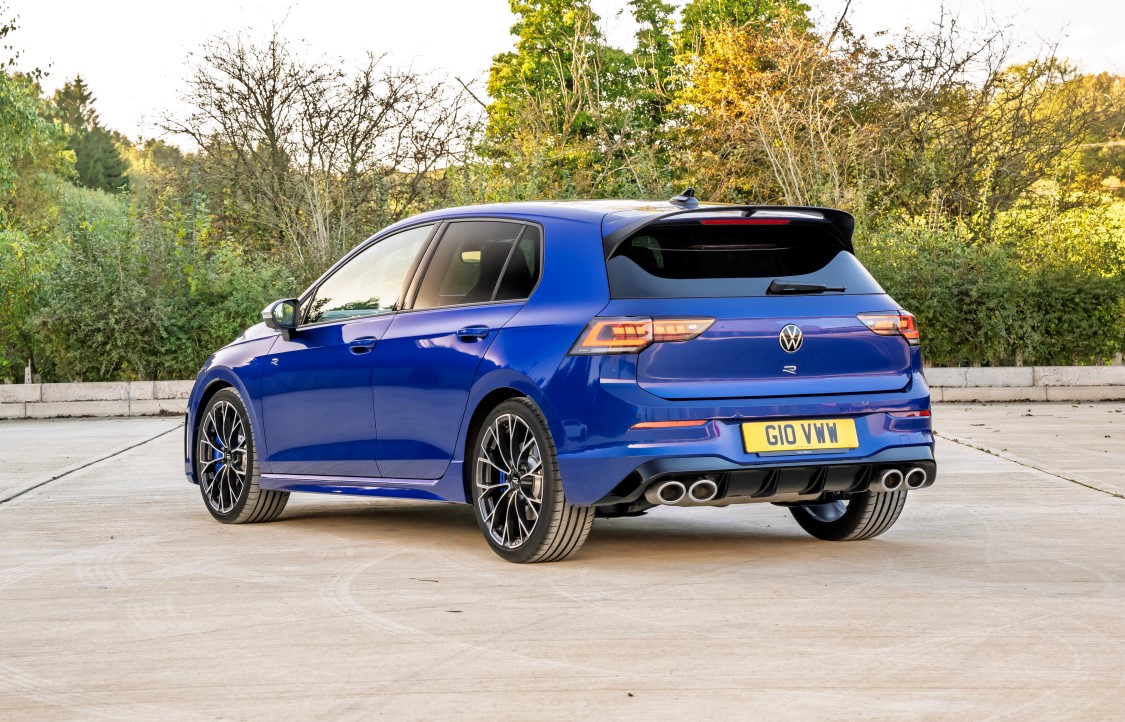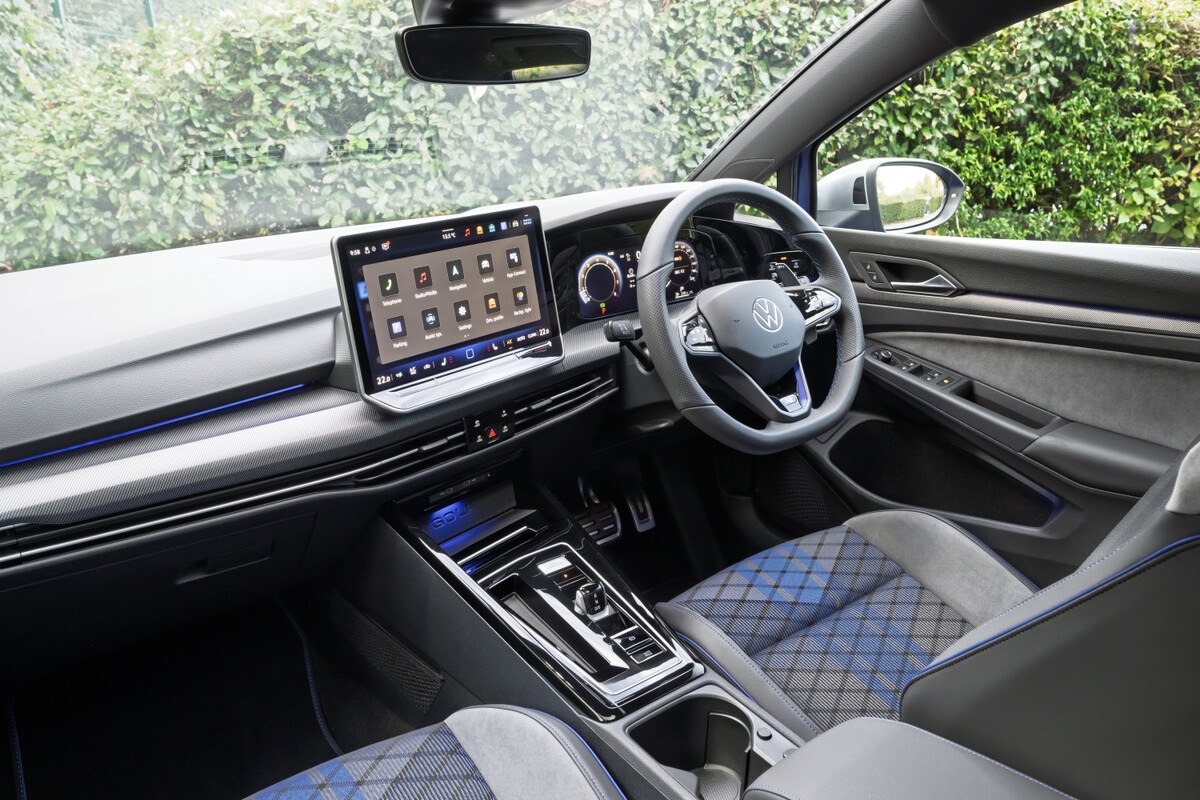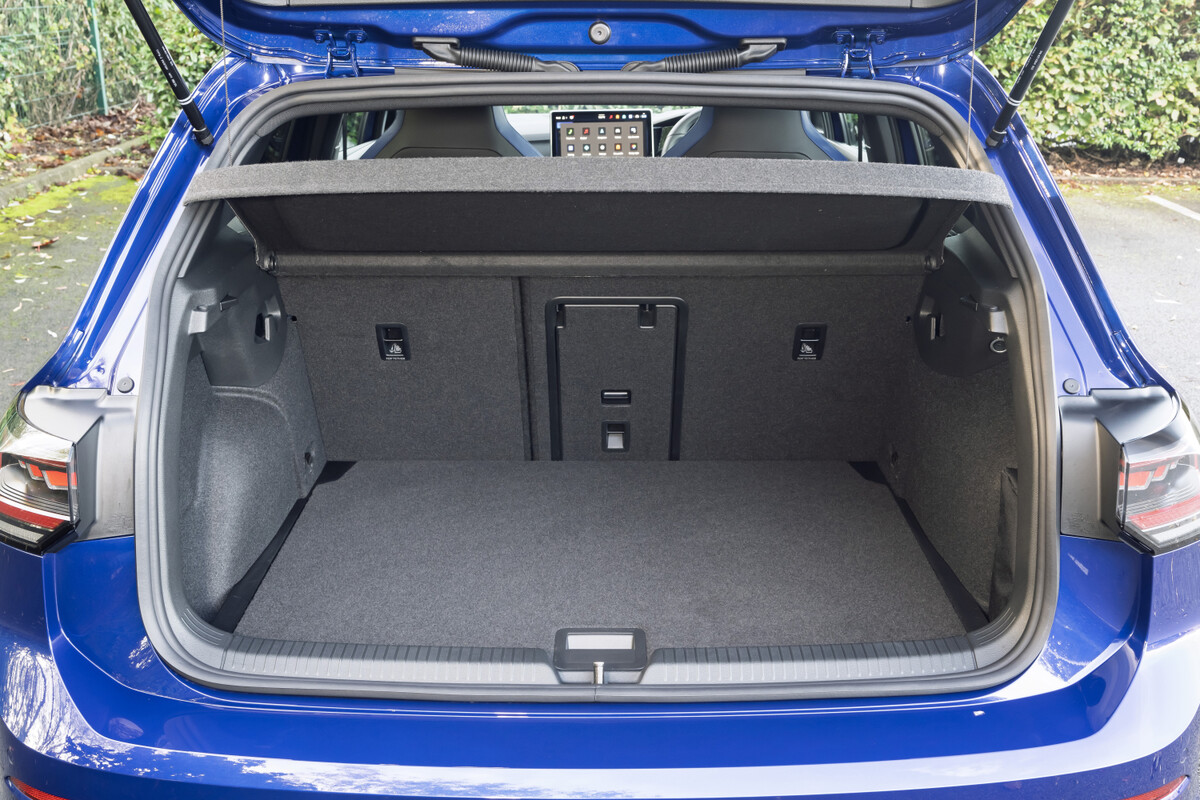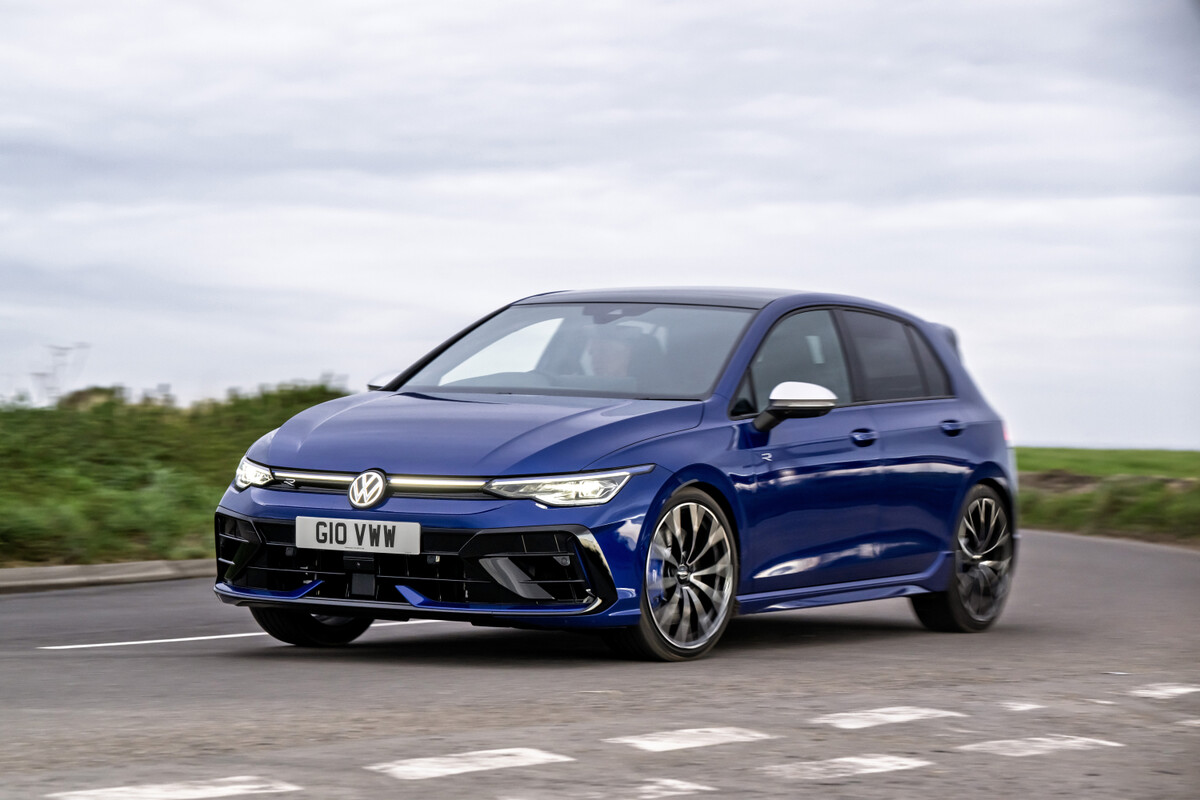
RAC sale – up to 33% off*
• Roadside cover from £5.29 a month†
• We get to most breakdowns in 60 mins or less
• Our patrols fix 4/5 breakdowns on the spot

Volkswagen’s ultimate Golf has been updated with more power, fresher styling and improved tech. Is it still one of the best hot hatchbacks on sale? Lawrence Allan finds out.
Things you'll like
- Rapid, yet comfortable and quiet
- Drive modes add fun factor
- Cabin tech is now easier to use
Things to consider
- Expensive for a Golf
- There are more engaging hot hatches
- Haptic wheel buttons remain awkward
What is the Volkswagen Golf R?
Many cite the Volkswagen Golf GTI as the definitive original hot hatchback, and with nearly five decades of heritage, eight generations, and global success, that’s hard to argue with.
But the GTI isn’t the ‘ultimate’ Golf by any means. The early 2000s saw an advance towards a more serious type of hot hatch: one with more powerful, larger capacity engines, four-wheel drive and trick gearboxes. It’s the two generations of this giant-killing Golf – known as the R32 – that defined today’s Volkswagen Golf R.
We’re now well into the third generation of the Golf R as we know it. All feature the brand’s venerable turbocharged ‘EA888’ four-cylinder petrol engine, which has been upgraded over time to reach the 333hp output now featuring in today’s model.
Alongside a boost in power and response, the latest Golf R ‘Mk8.5’ benefits from tweaks to the drivetrain, chassis, exterior design and interior technology. It could well be the last high-performance Golf to feature a pure petrol engine as the move to electrification continues. So, is this last hurrah for internal combustion any good? We’ll find out in this review.
Verdict: is the Volkswagen Golf R a good car?
If you’re after a very fast, very capable hot hatchback or estate that ticks plenty of rational boxes too, then the Golf R is well worth a look. It’s a serious performance car when you want it to be, and almost as civilised as a regular Golf when you don’t.
It’s not exactly cheap, and lacks the fun factor of a Honda Civic Type R. But the technology and kit upgrades for the facelift have made it more complete than ever.
Pricing, specs & rivals
As of late 2024 list prices for the Mk8.5 Volkswagen Golf R kick off from £43,895 for the entry-level model, with the estate variant priced at £45,295.
For context, the R hatchback is around £4,500 more expensive than an entry-level Golf GTI, and a tempting £1,700 or so more than the GTI Clubsport - not bad given the extra performance and all-wheel drive. Meanwhile, the Golf R Black Edition starts from £45,145 and isn’t available as an estate at launch.
Don’t dismiss the Black Edition as a simple styling upgrade, though. Yes, you get black exhaust tips, black brake callipers, black 19-inch wheels and other darkened exterior details. But it also receives the R Performance Package which brings a bigger roof spoiler, a top speed raised from 155mph to 168mph, a lap timer, a G-meter and two exciting new drive modes (more on that in the driving section).

Equipment on the regular model isn’t exactly miserly, though. You get 18-inch alloys, matrix LED headlights, heated seats, three-zone climate control, adaptive cruise control, keyless entry, multi-colour ambient lighting, wireless phone charging – basically, everything you’d find on a high-end version of a regular Golf.
Rivals? Well, if all-wheel drive and a premium image are must-haves, you really can’t ignore the slightly cheaper BMW M135i, or the slightly more expensive Audi S3 and Mercedes-AMG A35.
Beyond that the list of hot hatchbacks on sale seems to grow smaller by the week, but the outrageously exciting Honda Civic Type R is well worth a look. As for the Golf R Estate? It effectively has one (very closely related) rival in the form of the Cupra Leon ‘333’ estate with the same engine and drivetrain.
Volkswagen Golf R: Interior comfort, quality & technology
Changes to the Golf R’s cabin in 2024 don’t appear extensive at first glance – really the main upgrade is one that’s detailed in the infotainment section, below.
It’s a (mostly) logical interior with a typically Volkswagen sense of solidity and purpose. Some improvements in the odd trim finish on the doors and dash help uplift the quality feel a little over the outgoing car. Fans of manual shifting will also be pleased to see that the tiny old wheel-mounted gearshift paddles are larger and more tactile to use, too.
Other R-specific touches, such as metal pedals, blue cabin details and R-branded floor mats, remain untouched. Options include real carbon-fibre trim inserts and Nappa leather seats – we’d personally consider the latter because the R’s standard cloth seat looks and feels like something you’d see on a local bus in the early 2000s.
There’s little complaint regarding the seat’s shape, though: it’s supportive and well-bolstered to hold you in place in hard cornering, while still being comfortable for long drives. Adjustable lumbar support is standard, too, while there’s a wide range of adjustment in the overall driving position to make it easy to feel at home.
The Golf’s relatively boxy shape – both in hatchback and estate forms – also means good all-round visibility, though the standard all-round sensors and rear-view camera come to the rescue if you still need help when parking.
It’s a shame, though, that unlike other Mk8.5 Golfs the R doesn’t ditch the haptic steering wheel buttons in place of old-school physical ones. VW claims that’s because there wouldn’t be enough space for the bespoke R mode selector, but it seems a poor compromise when the touch-sensitive panels are so fiddly and easy to brush by accident on the move.

Infotainment, sat-nav, stereo and connectivity
VW has been responsive to criticism of the Mk8 Golf’s infotainment system, making significant changes for the MK8.5 which also apply to the Golf R.
For starters, the touchscreen itself is up from 10.2in to 12.9in in size. While that makes it a bit more imposing in your eyeline, it does make it much easier to select functions on the move. Another key upgrade is a customisable home screen, while the overall menu layout is more accessible, too. The screen itself is bright, clear and decently responsive.
The controversial volume and temperature touch sliders below the screen remain, but we’re pleased to report that VW has finally backlit them so they’re usable at night.
Wireless Android Auto and Apple CarPlay feature alongside a standard wireless phone charging pad if you prefer a standardised interface, and that works well. Meanwhile the digital driver’s display remains largely the same as before, but that never gave much cause for concern.
Two USB-C connections feature in the front and rear, too. We’d consider upgrading the standard six-speaker audio system to the reasonably-priced Harman Kardon system, which has a sound quality more in-keeping with the car’s price tag.
How practical is the Volkswagen Golf R?
The Golf R doesn’t demand too much sacrifice in terms of space for passengers and luggage over a regular Golf. That means it’s ample for a small family or a quartet of adults, but not the roomiest hot hatchback on the market.
Up front there’s plenty of room for adults of all shapes and sizes to get comfortable, with no shortage of leg space or headroom. Decent cabin width also means you’ll avoid knocking elbows with your front seat passenger.
Rear seat space is pretty good overall, if not outstanding. A pair of six-footers can fit behind similarly sized adults without too much complaint, but the bulky front sports seats do cut out a little legroom compared to the regular Golf.
A third adult in the rear won’t exactly find generous shoulder width or legroom, either – a Honda Civic Type R is substantially more spacious in the rear. Still, the Golf is on a par with (or slightly more spacious than) its premium German alternatives. ISOFIX points are easily located for each outer rear seat, too, and the doors open fairly wide for loading child seats.
The Golf R Estate has a slightly longer wheelbase than the hatchback, adding just under 4cm more legroom in the rear. That’s worth bearing in mind if you’re considering which is best for you.
Storage and boot space
There’s nothing special on offer with the Golf R’s cabin storage – but nor is there much to complain about. You’ll find the same decent sized door bins and usable glovebox as the regular model, plus a pair of cupholders that can be stowed at the press of a button to open up the centre console space. A usable bit of armrest storage and a shelf for your smartphone completes the front.
In the rear you’ll find another pair of chunky door bins, some cupholders in the centre armrest and pockets in the rear seatbacks – including smaller ones at the top of the seatback for phones and suchlike. The seatbacks fold in a 60/40 split for both the hatch and estate.
One area that is changed over the standard Golf is the boot space. At 341 litres in capacity, it sacrifices 41 litres for the car’s all-wheel drive system – but that’s mainly taken from the underfloor storage. The overall space is more than an Audi S3 but less than a BMW M135i and Civic Type R. It’s a useful square shape with a low load lip thanks to the adjustable boot floor, however.
Of course, where all the Golf R’s rivals can’t compete is the availability of an estate version (if you discount the pricier Mercedes-AMG CLA35). That holds an impressive 611 litres of space in a nicely-shaped load bay – cue the “all the car you ever need” clichés here.

Performance & drive: What is the Volkswagen Golf R like on the road?
The outgoing Mk8 Golf R was hardly lacking in the speed department, but progress is progress: Power is uplifted a touch from 320hp to 333hp, although torque remains the same, resulting in a fractionally quicker 0-62mph time you’d be hard pressed to notice in the real world.
What you may notice is an engine upgrade carried over from the old Golf R 20 Years special edition (with which the new car shares its power output). It’s effectively an ‘anti-lag’ system, allowing the turbocharger to keep spinning for a few seconds after you lift off the throttle. This means there’s no brief pause when you get back on the as the turbo spools back up, improving response noticeably.
Whether you’re firing it off the line using the Launch Control function or accelerating in-gear, the Golf R always feels exceedingly rapid. More so, even, than rivals from BMW and Mercedes. It pulls strongly from practically anywhere in the rev range, while the dual-clutch gearbox (no manual is available) is swift to react to the pedals or kickdown.
Where it is still a bit lacking, though, is character. That’s both in the way it delivers its power in an undramatic and linear way, but also the engine noise itself. VW has tried to inject a bit more excitement at start-up with the rowdy ‘Emotional Start’ feature (hold the start button down for a couple of seconds without pressing the brake), the soundtrack when driving is subdued and uninspiring even by modern standards.
Upping the ante in the sportier drive modes merely ups the volume synthetically via piped-in engine noise through the speakers, though even that is a bit anodyne. Even the expensive optional Akrapovic titanium exhaust – hamstrung as it is by external noise regulations – does little to get the hairs on the back of your neck standing up bar the addition of some pops and bangs.
While the M135i and Audi S3 are similarly afflicted, the Mercedes-AMG A 35 has more aural charm. And so, oddly, does another hot Golf: the GTI Clubsport. While it shares the same basic engine hardware in a lower state of tune, VW has given the piped-in sound a more multi-layered effect. So even if you aren’t going quite as quickly as in the R, we reckon your ears will be more satisfied.
Power, 0-62mph times (H4)
- Golf R Hatch: 333hp/4.6 secs
- Golf R Estate 333hp/4.8 secs
Ride and handling
Key to the Golf R’s appeal has always been its giant-killing point-to-point pace combined with everyday usability. The Mk8 is probably the most accomplished Golf yet on those fronts. But does the 2024 update add anything further?
Well, you get a new Eco drive mode that softens the throttle response and gearchanges. But that’s not going to titivate enthusiasts. What might is a new Sport+ mode, which serves as a custom mode for all your preferred settings for the gearbox sharpness, throttle response, augmented soundtrack and – when specified – your ‘DCC’ adaptive damper preference.
The latter is an option we’d recommend ticking (curiously, it’s standard in Germany), because there’s a wide range of adjustability allowing the ride to go from firm and aggressive to almost plush-feeling by hot hatch standards.
It’s that duality, from cruiser to back road blaster, that’s core to the R’s appeal. Opt for the Performance Pack (standard on the Black Edition) and you’ll also get a Nürburgring mode, which is effectively Race mode with the suspension stiffness dialled back a notch. A Drift mode also features, although this isn’t any use outside of track conditions.
Outside of some drive mode tweaks the Mk8.5 Golf R is much the same as before. That means ferocious grip, tight body control and a clever four-wheel drive system that can send power not only between the front and rear axle, but also between individual rear wheels. This helps quell understeer and fire you out of a tight corner with confidence. The steering is faithful and ideally weighted, too, while dial everything back and it’s essentially as easy to drive as a regular Golf.
But one key reservation remains: is it fun? It’s mightily impressive, sure, and more surefooted than any sports car on craggy, damp British tarmac. However, there’s an ever-present feeling that it’s almost too capable for its own good: you’ll never reach its limits away from a racetrack, and it doesn’t engage you anything like as much as a Civic Type R at normal road speeds.
Maybe it’s the lack of a manual gearbox. Or maybe it’s the unstickable four-wheel drive system. But, on the same day and in the same conditions, we reckoned there was more fun to be had with the slightly slower, front-wheel drive Golf GTI Clubsport, which trades all-weather capability for a feeling that the driver needs to put more in to get similar results.
Noise and refinement
Given its sporting intent it shouldn’t be a surprise that the Golf R isn’t quite as soothingly serene as a regular Golf. But by the fastest hot hatch standards it’s very refined. Even BMW and Mercedes-Benz’s alternatives can’t match the R’s lack of suspension noise and tyre roar, and while rough motorway surfaces can be heard they rarely impede on the VW’s pleasant cruising manners. Wind noise, too, is rarely an issue.

Euro NCAP: is the Volkswagen Golf R a safe car?
Putting its huge performance capability to one side, the Golf R is no less safe than a regular Golf according to Euro NCAP. The same maximum five-star rating applies here, with strong results in each category.
The Golf R gets the expected array of airbags including curtain airbags and a centre airbag in the front. However, rear curtain airbags are on the options list.
The usual safety assist equipment features, including autonomous emergency braking with pedestrian and cyclist detection, post-collision braking, lane keeping assistance and traffic sign recognition. A driver drowsiness monitor also comes as standard, as does rear traffic alert and an exit warning system.
Running costs and fuel economy
Any powerful hot hatch such as the Golf R demands some financial compromise, both with the cost of buying or leasing one in the first place and the day-to-day running costs.
According to official combined WLTP figures the regular hatch manages up to 34.8mpg combined, with the Black Edition and Estate model taking an insignificant 0.3mpg hit. In our experience you might beat that figure at a steady motorway cruise, but it’ll fall well below that in town.
For comparison an M135i is slightly more efficient on paper, while an S3 or A35 are broadly similar. However, like its rivals the Golf R is stung by both emissions-based first year road tax (VED) and the Expensive Car Supplement for cars with a list price over £40k.
For the former, it means all Rs have a £1,095 first-year tax rate included in the list price, and for the latter you’re looking at £600 a year in VED for the first five years after the car’s registration.
How much does the Volkswagen Golf R cost to insure?
Anyone familiar with hot hatchbacks knows that they command a premium when it comes to insurance costs, and the Golf R is no different – but it is at least in line with rivals. Insurance groups for the 2024 Golf R start at group 33 from the standard model, rising to 34 for the Black Edition. That’s pretty much identical to the Mercedes-AMG A35 and BMW M135i, and considerably lower than the Honda Civic Type R.
Volkswagen Golf R FAQs
Is the Golf R faster than the Golf GTI?
Yes, the VW Golf R is faster than any version of the Golf GTI. With 333hp, four-wheel drive and a 0-62mph in just 4.6 seconds, the Golf R is seriously fast, while with the Performance Pack it’ll do 167mph flat-out. Even the fastest Golf GTI, the Clubsport, has 300hp, front wheel drive, a 0-62mph time of 5.6 seconds and a top speed of 155mph.
Do the Golf R and Golf GTI have the same engine?
Sort of, yes. Both the Golf R and the Golf GTI use the same 2.0-litre four-cylinder ‘EA888’ turbo petrol engine mated to a seven-speed dual-clutch transmission. However, the Golf R has a higher state of tune than any version of the Golf GTI, making more power and torque.
How much does the VW Golf R cost?
As of late 2024, the latest Volkswagen Golf R costs just under £44,000 in standard for, rising to just over £45,000 for the Black Edition. The Golf R Estate, meanwhile, starts from £45,300.










